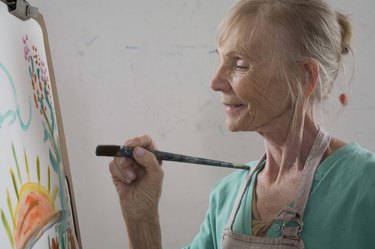
Creating gradual fading, blending or transitioning from one area of paint color to another is best done slowly with thinner layers of paint, using a technique called glazing. You will have better luck with an oil paint for this, as it offers a longer time to work it before it dries. If you use acrylic, add a retarder to the mixture, which will slow the drying process.
Fading and Transition Techniques
Video of the Day
Start with the lighter color and work the darker color into it. It is much harder to cover a darker color like a dark blue or a black with white or yellow, for example. Once you have the lighter area of the fade painted, paint the darker area from the other side of the transition, and slowly paint into the lighter area, which should still be wet. This will create a natural transition and fade, as the lighter and darker shades blend. Use paint that is not fully opaque so you have more control. If you start with an opaque black and you make a mistake (say, by pulling the black into the lighter area past the point where you want the transition to begin) it is more difficult to correct.
Video of the Day
Don't use a thick, pasty paint; a liquid paint with flow is best. If the paint is too tacky or gummy, add more medium to thin it. Don't use just solvent (for oil) or water (for acrylic) as they make the paint too watery and more difficult to work. A medium with linseed oil and damar or other varnish works best for oil; a prepared matte or gloss medium is best for acrylic as it will have more body than water.
Use a soft bristle brush, such as a sable or a synthetic sable, which is cheaper. The stiffer hog bristle brushes won't allow as subtle a fade as the softer brushes. Avoid foam brushes, which are not flexible enough, and fan brushes, which leave tracks if not used properly.
Once the darker color is in place, work the lighter color into the fade area from the other direction. The idea is to go back and forth until you get an even transition. If the fade is too abrupt or uneven, increase the opacity of the lighter paint and work it in from the light side to cover the flaws. This is not something that will look good on the first try; that's why the longer drying time is helpful. The other advantage of using the translucent glazes is that it will create a more atmospheric effect that will be more convincing (for things such as skies or light transitions on a wall) than the effect of opaque paint.